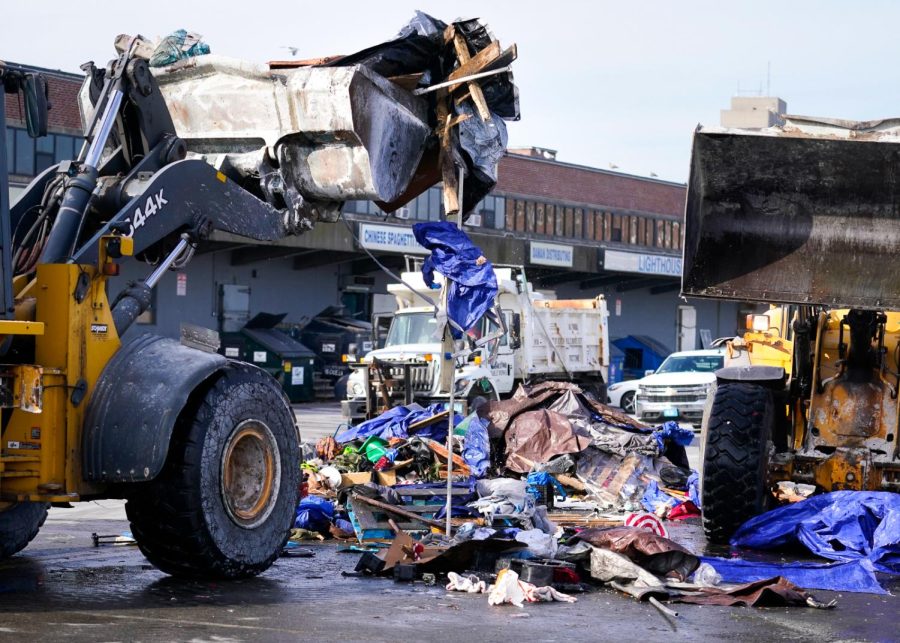Boston’s Policies Are Not Stopping Homelessness
At the physical intersection of Massachusetts Avenue and Melnea Cass Boulevard lies the intersection of Boston’s homeless, gentrification and substance abuse problems. On January 12, the City of Boston conducted a “sweep” of Mass and Cass, tearing down temporary encampments of the homeless, threatening to issue arrests on people staying behind and relocating approximately 150 people. The effort reflects Boston’s desire to address homelessness and its failures. To achieve long-term success, Boston needs to confront the root causes of homelessness: gentrification, substance abuse and the criminalization of homelessness itself.
Boston, like many cities, is guilty of counterproductive, anti-homeless policies that ban loitering, sleeping in public spaces and until 2020, begging, essentially incriminating the entire existence of homeless people. As a result, one in eight Bostonians arrested in 2019 was homeless, according to an investigation conducted by the Howard Center for Investigative Journalism. Homeless people comprise about two percent of Boston’s population. Critically, criminalizing the homeless hinders access to employment and education, draws stigma and reduces the income of ex-convicts, all of which hurts their ability to keep stable housing. Repealing and reforming these anti-homeless laws could play a powerful and necessary role in allowing homeless folks to accumulate savings and obtain housing, thus alleviating the city’s need to provide shelter.
The cost of housing across Boston has soared by over ten percent in the past year, in tandem with rising costs of living. This unprecedented growth is heavily driven by developers, who infiltrate low- and middle-income areas and convert affordable housing into upscale condos, displacing local residents in a process known as gentrification.
BLS history teacher Mr. Dominic Rinaldi, a lifelong resident of East Boston, says, “The local government [is] allowing the developers to do so. They grant all sorts of variances and exceptions for developments to get around conventional rules, etc., and in return, donations get made to campaigns. […] It forces one to have to make difficult decisions […] if you are lucky enough to have the options. For many others the difficult decisions get made for them,” and they are forced out of their city and possibly onto the streets. Instead of implementing dubious solutions to problems they are causing themselves, Boston’s government is better off focusing on preventing homelessness in the first place by combating gentrification, which would save time, money and lives.
Another serious and prominent cause of homelessness is addiction. Rates of substance abuse have accelerated in recent years, leading to a dangerous cycle. Aidan Ormsby (III) explains, “Because of our draconian drug laws, people are afraid to receive help in fear of being punished for possession.” Those struggling with substance abuse also experience higher rates of mental illnesses. This causes difficulties retaining employment and consequently health insurance, further decreasing access to treatment and stable income. The mess of problems turns into a positive feedback loop, where those battling addiction and mental illnesses enter a downward spiral, pushed further away from safe and secure housing. Without increasing access to treatment, more people will be forced onto the streets and become the city’s responsibility.
The recent sweep of Mass and Cass is one of the multiple instances where Boston has attempted to remove its homeless community over the past few years. Nonetheless, the homeless population keeps returning because the factors that cause them to lose their homes still exist and are only getting worse, on top of the poor conditions of public shelters. Although the city provided supportive housing to the 150 people they relocated, no resources were available to the individuals that were not present at the time of the sweep. While appearing to solve the city’s “health hazard,” the clear-out actually made it harder for people seeking temporary housing. WGBH News reported that at least 100 people have been left without shelter.
The current model ultimately fails as a long-term solution in part because of the deep stigma associated with substance abuse, mental illness and, consequently, homelessness, as well as the external factors that produce such conditions. The long-running and insulting misconception that one loses their home due to their own laziness or stupidity remains an obstacle to gaining public support for effective policy too. Placing the blame on homeless individuals, rather than the root causes, absolves society of any guilt and obligation to solve the more complex problems, many of which are the direct fault of Boston’s policies.
Sophia Ahearn (I), who has been studying perceptions around homelessness for her Senior Capstone project, adds, “Another important part about changing the perception around homelessness is that it will allow people to recognize that homelessness can fall upon anyone. And this is likely to compel people to think ‘this could easily happen to me too, and if this were me I would need the support.’ The perception surrounding homelessness right now makes us numb to the simple fact that individuals experiencing homelessness are human beings. Sharing stories of homelessness creates a sense of empathy, and from empathy comes [an] urgency to act.”







